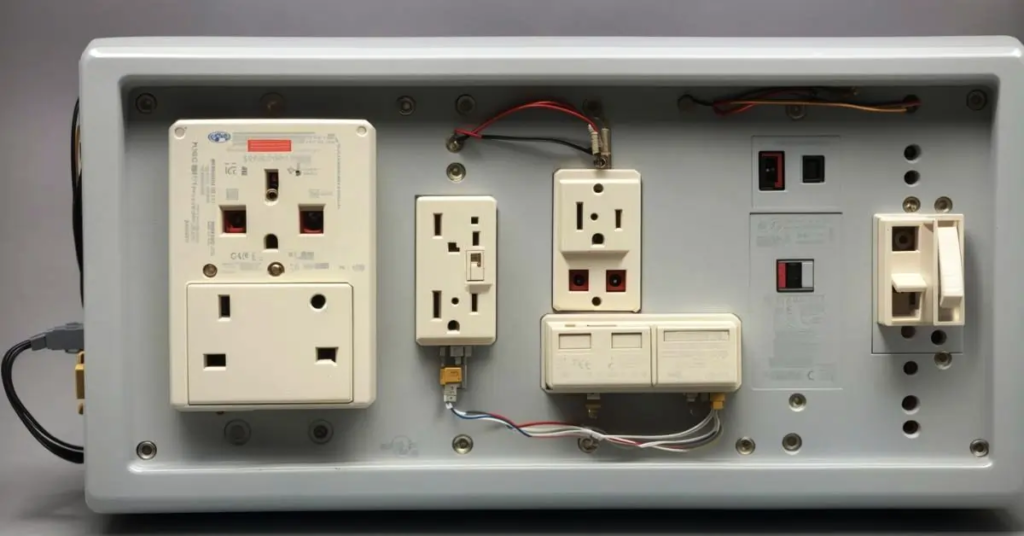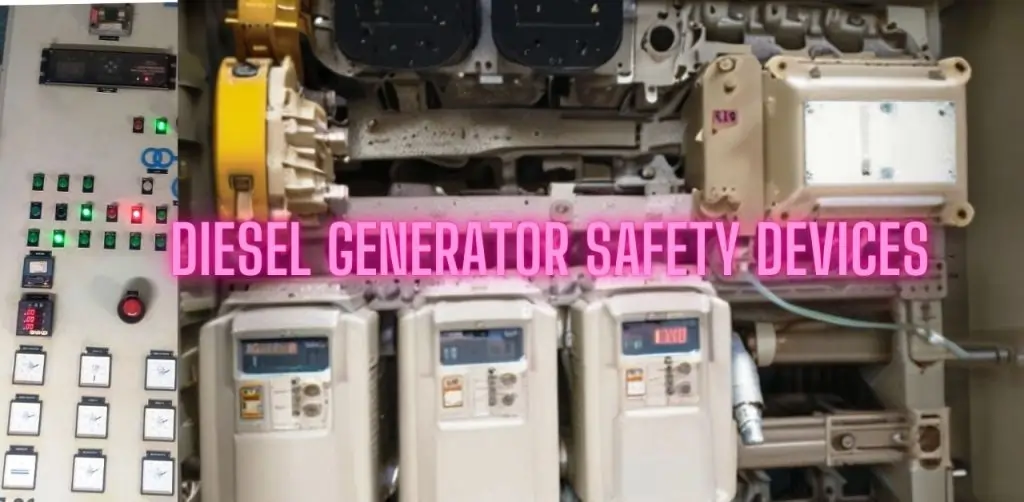Diesel generators serve as critical backup power sources in various applications, providing continuous power supply during grid outages or in remote locations. However, the reliable operation of these generators depends on the incorporation of robust Diesel Generator Safety Devices. These devices protect the generator and associated equipment from potential hazards, ensuring personnel safety and preventing costly damage.
This blog post provides a comprehensive guide to the essential safety devices commonly found in diesel generator installations. By understanding the functions and importance of these devices, engineers can ensure the safe and efficient operation of their power generation systems.
Overload Protection: Safeguarding Generator Integrity

Overload protection is a critical safety mechanism in diesel generators, designed to prevent damage caused by excessive electrical loads. This protection system ensures the generator operates within its design parameters, preventing costly repairs and downtime.
How it Works
The core component of overload protection is a circuit breaker. When the generator’s output current exceeds a predetermined threshold, the circuit breaker trips, interrupting the flow of electricity and disconnecting the load. This prevents overheating and potential damage to the generator’s windings and other components.
To restore power:
- Identify and Reduce Overload: The first step is to identify the source of the overload and reduce the electrical load on the generator. This may involve disconnecting non-essential equipment or redistributing the load.
- Reset Circuit Breaker: Once the overload is rectified, the circuit breaker can be manually reset, allowing the generator to resume operation.
It’s important to note that frequent overload conditions can indicate an undersized generator or improper load management. Regularly reviewing load requirements and ensuring the generator is adequately sized for the intended application are crucial for preventing overload situations.
By incorporating overload protection, generator manufacturers ensure the longevity and reliability of their equipment. This safeguard protects the generator from damage, ensuring it remains a dependable power source for critical applications.
Emergency Stop Button: Ensuring Rapid Shutdown in Critical Situations
The emergency stop button, often referred to as the E-stop, is a critical safety feature in diesel generator systems. It provides a fail-safe mechanism for immediate shutdown in the event of a malfunction or hazardous condition.
Function and Importance
The primary function of the emergency stop button is to override all other controls and initiate a rapid shutdown of the generator. This is crucial in scenarios where continued operation could pose a risk to personnel, equipment, or the environment.
The E-stop’s importance lies in its ability to:
- Mitigate Hazards: In situations such as engine runaway, fire, or electrical faults, the emergency stop provides a means to quickly isolate the generator and prevent escalation of the hazard.
- Protect Personnel: The E-stop’s accessibility and ease of operation enable rapid response in emergencies, safeguarding personnel from potential harm.
- Prevent Equipment Damage: By facilitating immediate shutdown, the E-stop can prevent extensive damage to the generator and associated equipment.
Types and Activation Mechanisms
Emergency stop buttons are designed for quick and intuitive activation. Common types include:
- Push Buttons: These are typically large, red buttons that require a firm push to activate.
- Pull Cords: These are cords that, when pulled, trigger the emergency stop mechanism. They are often used in larger installations where the button may not be easily accessible.
- Mushroom-Head Buttons: These buttons have a large, mushroom-shaped head that is easy to grip and activate, even in challenging conditions.
The activation mechanism of the emergency stop button is designed to be simple and unambiguous, ensuring that anyone can initiate a shutdown in an emergency.
Circuit Breakers: Ensuring Electrical System Integrity

Circuit breakers are critical components in diesel generator installations, providing protection against overcurrent conditions that can lead to equipment damage and safety hazards. These devices automatically interrupt the flow of electricity when a fault is detected, safeguarding the generator and connected electrical systems.
Functionality of Circuit Breakers
Circuit breakers are designed to respond to two primary fault conditions:
- Overloads: An overload occurs when the current flowing through a circuit exceeds its rated capacity for a sustained period. This can lead to overheating and potential damage to conductors, insulation, and connected equipment. Circuit breakers are designed to trip and interrupt the current flow when an overload condition is detected, preventing damage and ensuring safety.
- Short Circuits: A short circuit is a fault condition characterized by an abnormally low resistance path between two points in an electrical circuit. This results in a dramatic increase in current flow, potentially leading to arcing, fire, and equipment damage. Circuit breakers provide rapid protection against short circuits by quickly interrupting the fault current.
Types of Circuit Breakers in Diesel Generators
The selection of circuit breakers for diesel generators depends on factors such as the generator’s capacity, voltage level, and the specific protection requirements of the application. Common types include:
- Thermal-Magnetic Circuit Breakers: These utilize a combination of thermal and magnetic elements to sense overcurrent conditions. The thermal element responds to prolonged overloads, while the magnetic element provides instantaneous tripping for short circuits.
- Molded Case Circuit Breakers (MCCB): MCCBs are robust circuit breakers suitable for higher current ratings and offer adjustable trip settings. They provide protection against both overloads and short circuits.
- Air Circuit Breakers (ACB): ACBs are heavy-duty circuit breakers designed for high-voltage and high-current applications. They utilize air as the arc-extinguishing medium and offer excellent protection against severe fault currents.
Ground Fault Protection: Ensuring Electrical Safety

Ground fault protection is a critical safety measure in electrical systems, including those associated with diesel generators. It safeguards personnel and equipment from the hazards of ground faults, which can lead to electric shocks and equipment damage.
Understanding Ground Faults
A ground fault occurs when an unintended path for electrical current flows to the ground. This typically happens when a live conductor comes into contact with a grounded surface or equipment. Ground faults can be caused by insulation failure, damaged wiring, or accidental contact with live components.
Hazards of Ground Faults
- Electric Shock: When a person comes into contact with a grounded surface that is experiencing a ground fault, they can receive an electric shock. The severity of the shock depends on the magnitude of the current and the duration of contact.
- Equipment Damage: Ground faults can cause excessive current flow, leading to overheating and damage to electrical equipment. This can result in costly repairs and downtime.
- Fire Hazard: In some cases, ground faults can ignite flammable materials, leading to fire hazards.
Ground Fault Protection Devices
Ground fault protection devices, such as Ground Fault Circuit Interrupters (GFCIs), are designed to detect and interrupt ground faults rapidly. They operate by continuously monitoring the current flowing in the live and neutral conductors of a circuit. Under normal conditions, these currents should be equal. However, in the event of a ground fault, a difference in current will be detected.
When a ground fault is detected, the GFCI quickly trips, interrupting the current flow and isolating the fault. This prevents electrical shocks and protects equipment from damage.
Benefits of Ground Fault Protection
- Enhanced Personnel Safety: GFCIs significantly reduce the risk of fatal electric shocks, particularly in wet or damp environments.
- Equipment Protection: By quickly interrupting ground faults, GFCIs prevent damage to electrical equipment and minimize downtime.
- Fire Prevention: GFCIs help prevent fires caused by ground faults by quickly isolating the fault and preventing arcing.
Overcurrent Inverse Time Relay (OCIR): Protection with a Time Delay
Overcurrent inverse time relays (OCIRs) are vital protection devices in power systems, including those utilizing diesel generators. They provide crucial protection against overcurrent conditions, ensuring the stability and integrity of the electrical network.
Function of OCIR
OCIRs are designed to trip and interrupt the flow of electricity when the current in a circuit exceeds a preset value. This protects equipment from damage caused by excessive current flow, which can lead to overheating and potential failure.
Inverse Time Characteristic
A key feature of OCIRs is their inverse time characteristic. This means that the tripping time of the relay is inversely proportional to the magnitude of the overcurrent. In simpler terms, the higher the overcurrent, the faster the relay will trip. This characteristic allows for selective coordination of protection devices in a power system.
Selective Protection with OCIR
Selective coordination ensures that only the necessary protective device operates in response to a fault, minimizing disruption to the rest of the system. For example, in a system with multiple OCIRs, the relay closest to the fault will trip first, isolating the faulty section while allowing the rest of the system to continue operating.
The inverse time characteristic of OCIRs is crucial in achieving selective coordination. By providing a time delay that is inversely proportional to the fault current, OCIRs allow downstream devices to operate first for faults within their zone of protection, while upstream devices provide backup protection for larger faults.
Negative Phase Sequence (NPS) Protection: Safeguarding Rotating Machines
Negative phase sequence (NPS) is an undesirable condition in three-phase power systems that can have detrimental effects on rotating machines such as generators and motors. NPS protection devices are crucial for detecting and mitigating these conditions, ensuring the reliable operation of critical equipment.
Understanding Negative Phase Sequence
In a balanced three-phase system, the voltages and currents in each phase have equal magnitudes and are 120 degrees apart in phase angle. However, under certain fault conditions, an imbalance can occur, resulting in a negative phase sequence component. This component has a rotational sequence opposite to the normal positive sequence.
Effects of NPS on Generators and Motors
- Increased Losses and Heating: NPS currents induce opposing magnetic fields in the rotor of rotating machines, leading to increased losses, excessive heating, and potential damage to windings and insulation.
- Mechanical Stress: NPS currents can also induce mechanical stresses in the rotor, potentially leading to shaft fatigue and premature failure.
- Reduced Efficiency: The presence of NPS currents reduces the overall efficiency of generators and motors, increasing energy consumption and operating costs.
NPS Protection Devices
NPS protection devices are designed to detect the presence of negative phase sequence currents and initiate protective actions to prevent damage to rotating machines. These devices typically utilize phase angle measurements to identify the negative sequence component.
When a significant NPS condition is detected, the protection device may:
- Issue an Alarm: Alerting operators to the presence of the imbalance.
- Trip the Circuit Breaker: Disconnecting the machine from the power supply to prevent damage.
- Reduce Excitation: In the case of generators, reducing the excitation current can help mitigate the effects of NPS.
Current Differential Protection: Rapid Fault Detection
Current differential protection is a highly effective method used to protect electrical equipment, including generators and transformers, from internal faults. It offers fast and sensitive fault detection, minimizing damage and ensuring the stability of the power system.
Operating Principle
Current differential protection is based on Kirchhoff’s Current Law, which states that the sum of currents entering a node must equal the sum of currents leaving 1 that node. In the context of electrical equipment, this means that the current flowing into a protected zone (e.g., a generator winding) should be equal to the current flowing out of that zone under normal operating conditions.
Current differential relays continuously monitor the currents entering and leaving the protected zone. If a fault occurs within the zone, such as a short circuit between windings, the current balance is disrupted. The relay detects this difference and initiates a trip signal to isolate the faulty equipment.
Advantages of Current Differential Protection
- High Sensitivity: Current differential protection is highly sensitive to internal faults, enabling it to detect even small imbalances in current. This allows for early fault detection and minimizes damage to equipment.
- Fast Operation: Differential relays operate very quickly, typically within a few milliseconds, minimizing the duration of the fault and reducing the extent of damage.
- Stability: Differential protection is inherently stable, meaning it will not trip for external faults or through faults outside the protected zone. This ensures that only the faulty equipment is isolated, minimizing disruption to the rest of the system.
- Selectivity: Differential protection can be highly selective, allowing it to pinpoint the location of the fault accurately. This enables faster troubleshooting and repair.
Reverse Power Trip Relay: Preventing Generator Motoring
A reverse power trip relay is a critical protection device used in power systems to prevent generators from operating as motors.1 This condition, known as “motoring,” can occur when the generator’s prime mover fails or is unable to provide sufficient power to maintain rotation.
Function of Reverse Power Relay
The primary function of a reverse power relay is to detect the flow of power in the reverse direction, i.e., from the grid to the generator.3 Under normal operating conditions, the generator supplies power to the grid.4 However, if the prime mover fails, the generator can start drawing power from the grid and operate as a motor. This can lead to several undesirable consequences.
Importance of Preventing Motoring
- Generator Damage: When a generator motors, it can cause mechanical stress and overheating, potentially leading to damage to the generator windings, bearings, and other components.
- Grid Instability: Motoring can also cause instability in the power grid, as the generator draws a large amount of reactive power from the grid. This can lead to voltage fluctuations and potentially affect the operation of other connected equipment.
- Safety Hazards: In some cases, motoring can create safety hazards for personnel working on or near the generator.
Reverse power relays prevent motoring by continuously monitoring the direction of power flow.5 When reverse power flow is detected, the relay initiates a trip signal, disconnecting the generator from the grid and preventing it from operating as a motor.6
By incorporating reverse power trip relays, power systems are protected from the detrimental effects of generator motoring.7 This safeguard prevents damage to the generator, ensures grid stability, and enhances the overall safety and reliability of the power generation system.

FAQ on Diesel Generator Safety Devices
Q: What does the emergency stop button do?
A: It’s like a big red “off” button that immediately shuts down the generator in emergencies.
Q: What does overload protection do?
A: It prevents damage to the generator when it’s overworked by too many appliances or equipment.
Q: Why do generators have circuit breakers?
A: They act like safety switches that automatically turn off the power if there’s a problem, like a short circuit.
Q: What’s the purpose of ground fault protection?
A: It protects people from electric shocks and prevents damage to equipment by quickly shutting off the power if there’s a problem with the electrical groundin
Conclusion
Diesel generators are indispensable for providing backup power, but their safe and reliable operation depends on the proper functioning of various safety devices. These devices protect the generator, connected equipment, and personnel from potential hazards associated with electrical faults, engine malfunctions, and overload conditions.
By understanding the functions and importance of these safety mechanisms, engineers can ensure the optimal performance and longevity of diesel generators, providing a dependable source of power when it is needed most.

